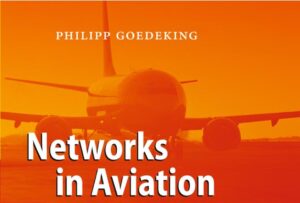The preface written by Dr.Christoph Franz (CEO of Lufthansa) welcomes readers.
Since Lufthansa Group serves more than 270 destinations under various brand names such as Lufthansa, Swiss, Austrian, bmi, Brussels Airlines, and Germanwings, Dr.Franz’s foreword is symbolically important.
In the first chapter, one can find the basic concepts and definitions of the aviation market such as market types, O&Ds, Routes, and Flights and some analysis methods like time series, upscaling, gravitation models and reverse engineering.

In the next chapter, there is a comparison of the structural, economic and strategic rationales of hub-and-spoke and point-to-point network architectures.
Beside that the operational basics of aviation network structures and key tools needed to master complex planning and the controlling of aviation networks can also be found in this chapter.
The third chapter analyzes the connectivity and the hub structures. The writer claims that the most effective driver of connectivity is the number of flight movements at a given hub, as the number of feasible hits greatly rises when compared to the number of underlying flight movements.
And to the contrary of what every other human in the aviation industry believes, the number of banks (a temporal cluster of inbound and outbound flights) correlates conversely with connectivity: the fewer the better.
Optimum asset utilization for airports is discussed in fourth chapter. The productivity of the assets deployed is at least as important as commercial objectives like connectivity. Infrastructural constraints can significantly impact efficient asset utilization. One of the most severe infrastructural constraints is the opening hours of airports.
In the fifth chapter two case studies discussed: one generic bottom-up case study and the other one, examining the top-down redesign of KLM’s hub for the winter schedule 2009 – 2010.
Sixth chapter mentions about the key organizational, structural, and procedural options for network management, the basic fundamentals of network control, and the most important IT tools for supporting such processes.
Here, route profitability concept is defined as “dangerous” and “toxic”. Instead, the writer suggests “negative opportunity cost” concept. This is especially valid for airlines with high transfer passenger share. Here “network value contribution” must be by no means favored against route profitability concept.
Next, Goedeking explains and discusses the competition and the alliance among airlines in terms of network structures. Here, the network overlapping between considered airlines is the main issue. He claims that the overlapping networks of two merging airlines are more advantageous than the complementary ones. Additionally he emphasizes that the potential synergy of a merger is highly unlikely to predict before.
Goedeking also examines the strengths and weaknesses of multi-hub structures, and introduces the tactics for assessing and improving synchrony within such complex networks. Soon after 1978 domestic market deregulation, networks with multiple major transfer hubs emerged in the United States, and European and Asian airlines quickly followed.
In multi-hub system scope and scale are considered. In scope type high yield is the goal while transfer passenger number is targeted in the scale type multi-hub systems.
US carriers have been following the multi-hub system for many years. But it is a new phenomenon for European counterparts. Air France KLM and Lufthansa are two good examples for multi-hubbing.
In the last two chapters of the book you can find how to examine the performance of a network and Goedeking’s hierarchically layered networks concept.
He combines the revenue management, scheduling and network planning components of an airline together.
He assumes a network in five layers.
At the bottom there is the passenger demand. On top of it is the network structure. Scheduling is added as the third layer. After this point, revenue management comes into the play. And as the last layer the communication, i.e. distribution channels take place in the layered network concept of Goedeking.
With this book one can discover the main aspects of an airline’s network structure. It has been written with a simple style which allows also people without deep knowledge about network management understand topics adequately. Since network planning can be described as the heart of an airline’s operation, I recommend everyone in airline business to read Networks in Aviation in order to get a very useful insight about this important point of airline management.
About the author
Dr. Philipp Goedeking advises airlines, airport operators, air navigation service providers (ANSPs), governmental authorities, and financial institutions around the world. His expertise includes network and alliance strategies, network synergy assessment, and airline mergers and acquisitions. Prior to founding airconomy, for 15 years he ran the aviation practice of the largest Europe-based strategy consultancy, including two years as managing director of the firm’s operations in China and five years on the firm’s supervisory board. Before that, he worked for Lufthansa in various senior positions in information technology, corporate strategy, and network management.
Book Information
Author: Dr. Philipp Goedeking
Title: Networks in Aviation – Strategies and Structures
Publisher: Springer-Verlag
Publishing Date: 2010
ISBN: 978-3-642-13763-1

